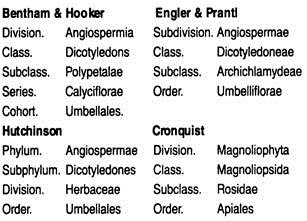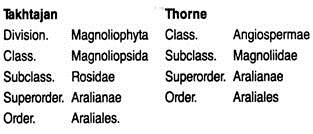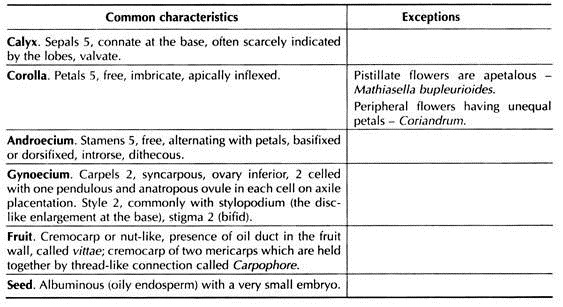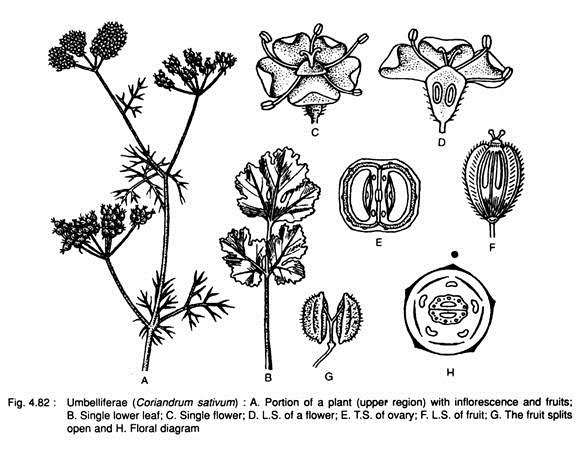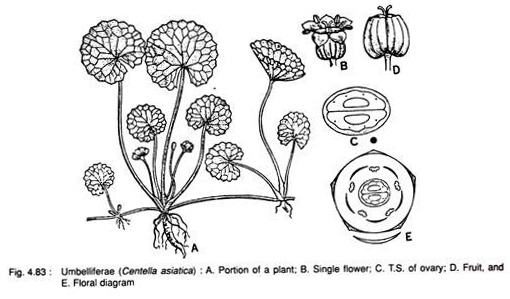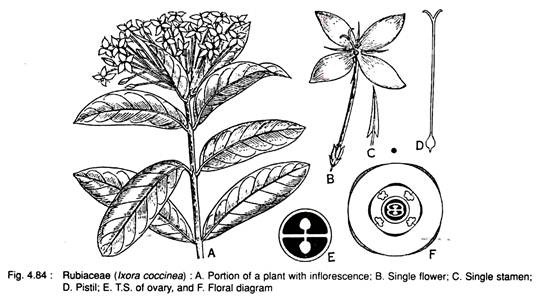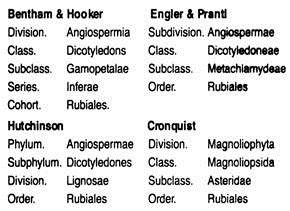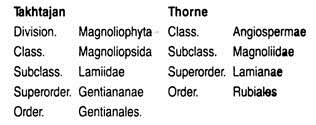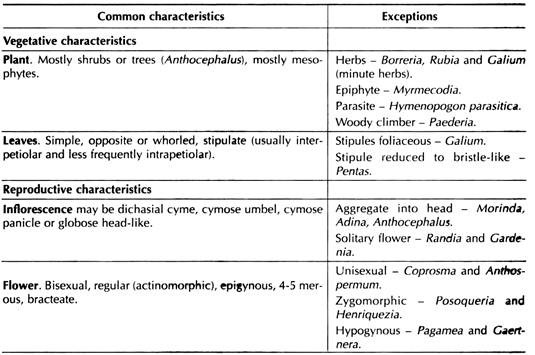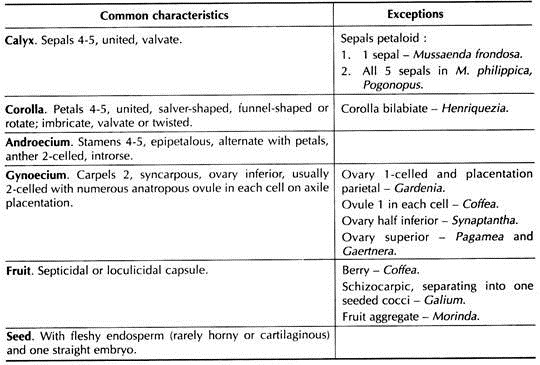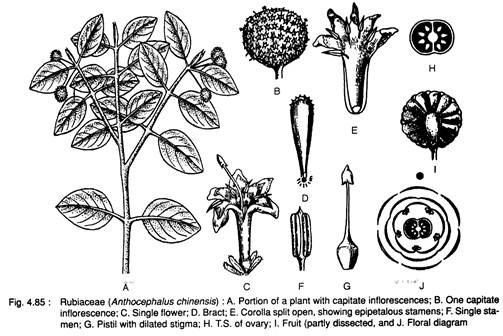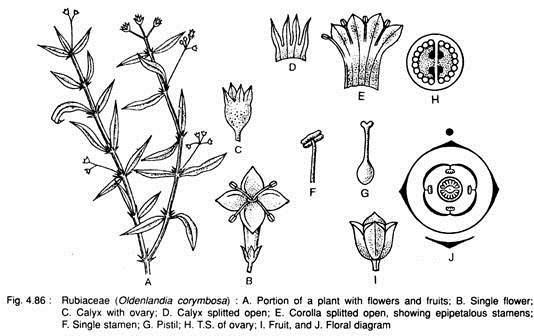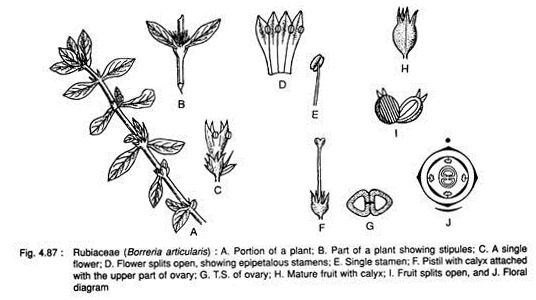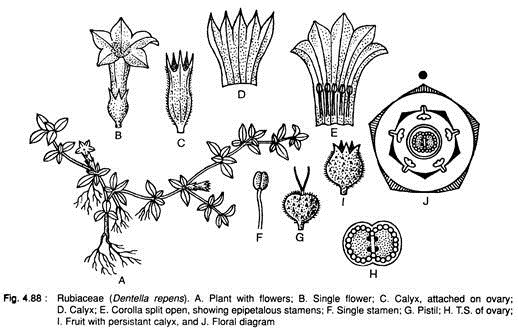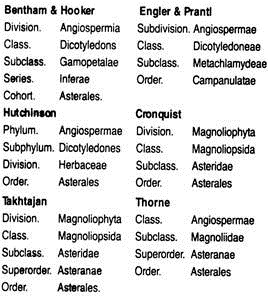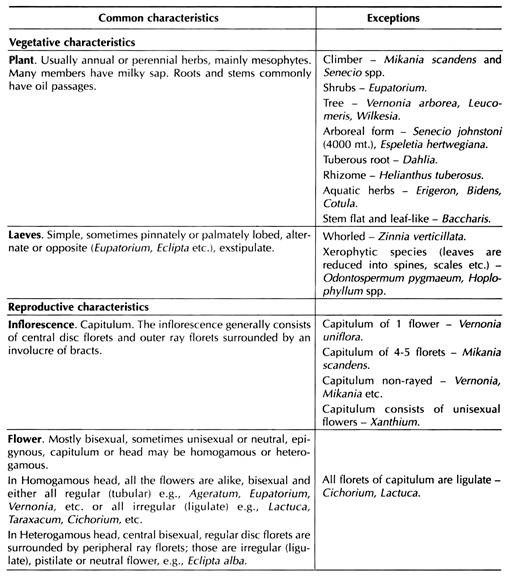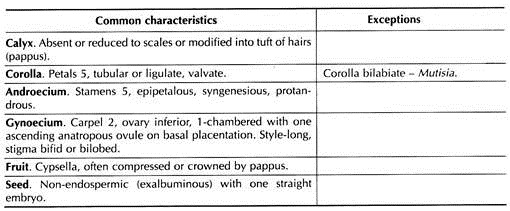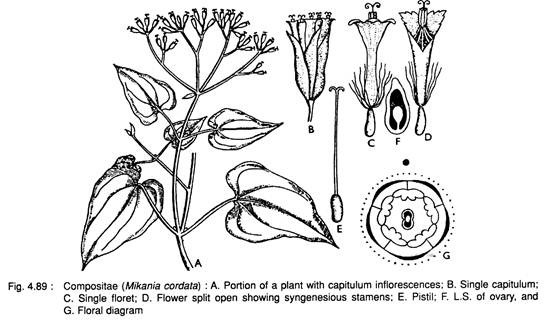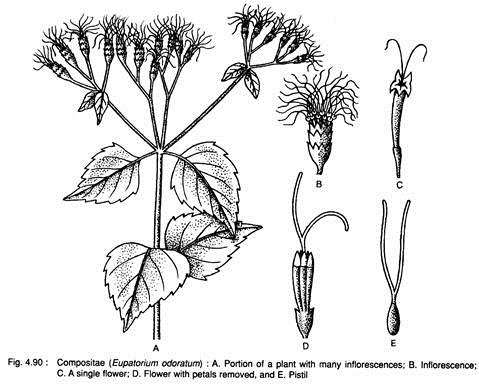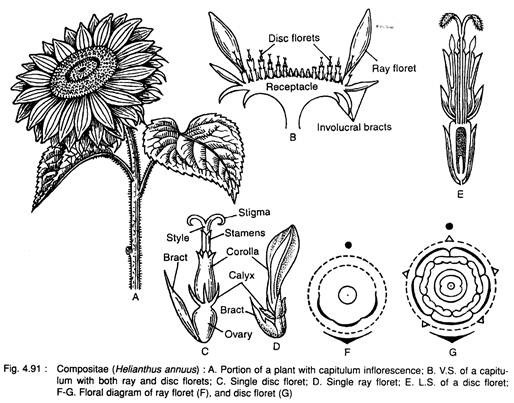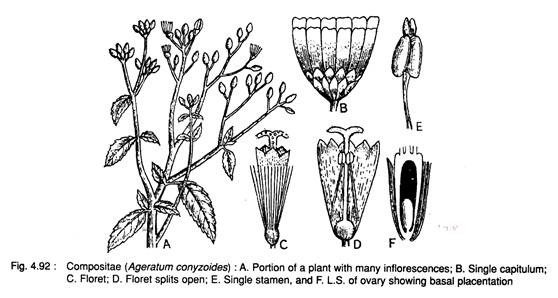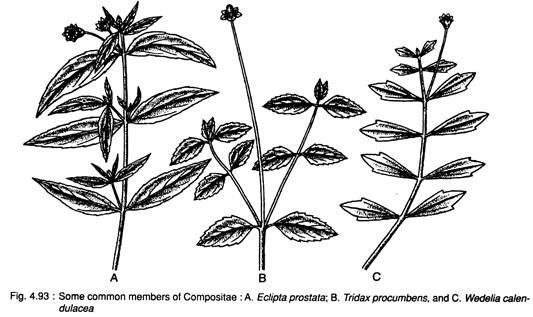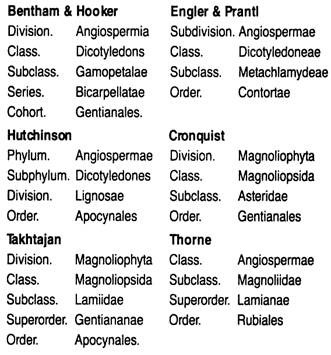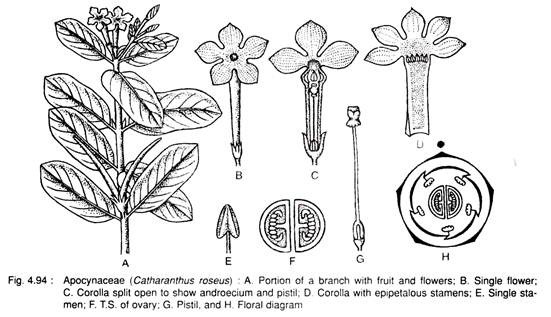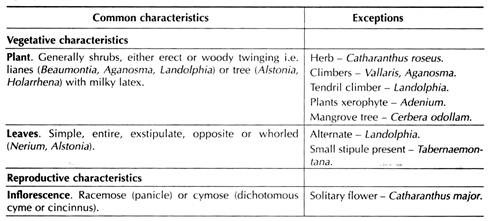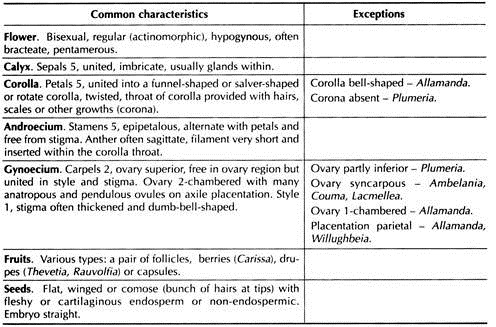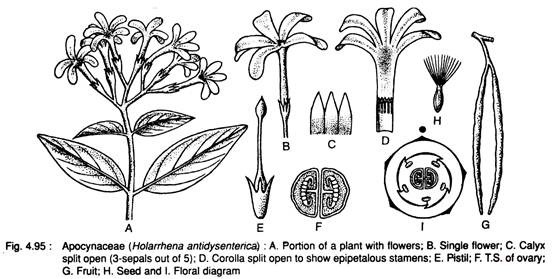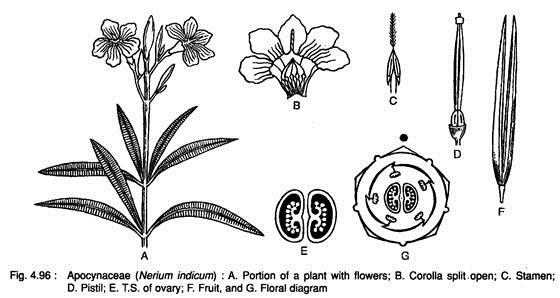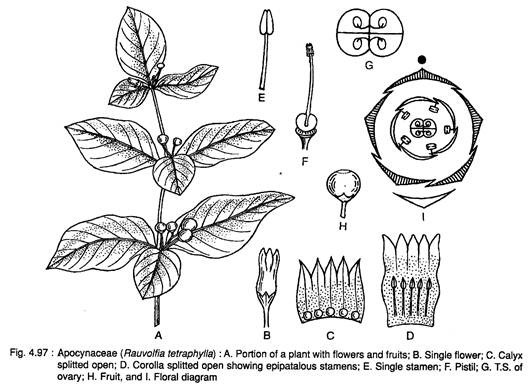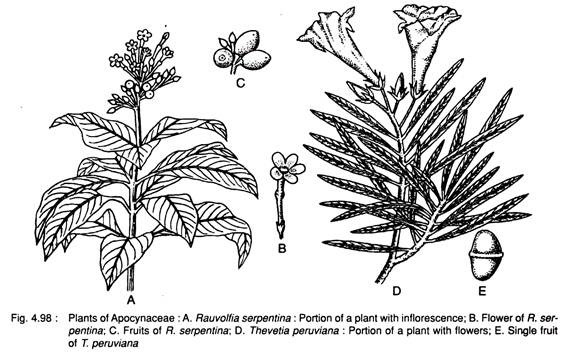Are you looking for an essay on the ‘Types of Dicotyledons’? Find paragraphs, long and short essays on the ‘Types of Dicotyledons’ especially written for school and college students.
Types of Dicotyledons
Essay Contents:
- Essay on Umbelliferae (Apiaceae) (Carrot Family)
- Essay on Rubiaceae (Madder Family)
- Essay on Compositae (Asteraceae)
- Essay on Apocynaceae (Dogbane Family)
Essay # 1. Umbelliferae (Apiaceae) (Carrot Family):
The family Umbelliferae consists of 421 genera and 3,220 species distributed throughout the world, but they grow abundantly in north temperate zone. In India, the family is represented by 53 genera and about 200 species found mainly in the temperate and alpine Himalayas, but some species are grown commercially in the warmer parts.
The type genus of the family is Apium.
Systematic Position:
Identifying Characteristics:
1. Plant aromatic herb, usually with hollow internodes.
2. Leaves alternate, simple or decompound with sheathing leaf bases.
3. Inflorescence, umbel (either simple or compound).
4. Flowers small, bracteate, bisexual and epigynous,
5. Perianth pentamerous,
6. Ovary inferior, 2-chambered; styles 2, free- stylopodic.
7. Fruit schizocarp (consists of two mericarps) or nut-like.
Floral Formula:
Umbelliferae: Distinctive Features: 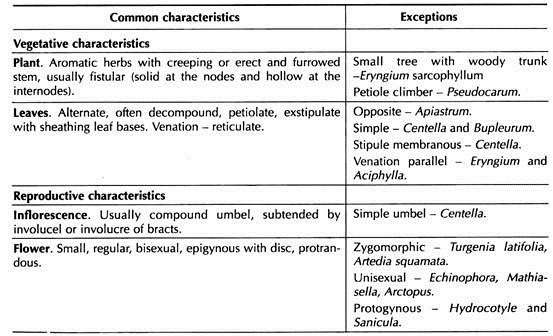
Phylogeny and Systematic:
The family Umbelliferae (Apiaceae) is closely related to the family Compositae and also with the members of Rhamnales.
Bentham and Hooker placed Umbelliferae in the cohort (= order) Umbellales, series Calyciflorae, subclass Polypetalae and class Dicotyledons. Engler and Prantl placed Umbelliferae in the order Umbelliflorae, subclass Archichlamydeae and class Dicotyledoneae. But Hutchinson treated this family as Apiaceae and placed it under the order Umbellales of division Herbaceae and sub- phylum Dicotyledones.
Common Plants:
1. Apium graveolens L. (Celery);
2. Carum carvi L. (Caraway);
3. Centella asiatica Urb. (Syn. Hydrocotyle asiatica L.) (Pennywort);
4. Coriandrum sativum L. (Coriander);
5. Foeniculum vulgare Gaertn. (Anise or Fennel);
6. Oenanthe javanica DC. (Syn. O. stolonifera Wall);
7. Seseli indicum W. & A.;
8. Trachyspermum amni Sprag. (Syn. Carum copticum Benth. & Hook.) (Ajowan or Jowan).
Key to Genera:
I. Leaves Simple:
Umbels simple………………………… Hydrocotyle.
Umbels compound …………………….. Bupleurum.
II. Leaves Compound:
1. Secondary ridges of the fruit not prominent
A. Primary ridges not winged:
i. Flowers yellow, furrows of the fruit vittate………….. Foeniculum.
ii. Flowers white, Furrows of the fruit 1-vittate:
a. Lobes of leaves linear, fruit ovoid, laterally compressed … Carum.
b. Each leaflet pinnate/partite, fruit not laterally compressed … Seseli.
c. Marshy herbs, leaves 1-3-pinnate, fruit longer than broad, carpophore 0……. Oenanthe.
B. Primary lateral ridges of the fruit excurrent, winged ………… Peucedanum.
2. Secondary ridges of the fruit prominent.
A. Involucre of bracts none, fruits glabrous ……………. Coriandrum.
B. Bracts of involucre numerous, pinnate, cultivated for its edible root, fruit hirsute Daucus.
Plants of Economic Importance:
The members of this family are important mainly for spices, condiments, vegetables, volatile oil and ornamental plants.
A. Spices and Condiments:
Seeds of different plants are used as spices and condiments for culinary purposes. Some are also used in flavouring cakes, biscuits, confectionary, etc. Oil obtained from the seeds is used in perfumery and as flavouring agent. Different seeds are used in medicines also.
These are:
1. Anethum graveolens (Dill, Sowa).
2. Apium graveolens (E. Celery seeds, H. Ajmud, B. Chanu).
3. Carum bulbocastanum (Black caraway).
4. C. carvi (E. Caraway, B. Jira).
5. Coriandrum sativum (E. Coriander, H. Dhania, B. Dhoney).
6. Cuminum cyminum (E. Cumin, H. Safed jira, B. Jira).
7. Ferula asafoetida (E. Asafoetida, H & B. Hing).
8. Foeniculum vulgare (E. Anise, Fennel; H. Saunf, B. Mouri).
9. Pimpinella anisum (Aniseed).
10. Trachyspermum ammi (Syn. Carum copticum) (E. Ajowan, B. Jowan).
11. T. roxburghianum (Syn. Carum roxbur- ghianum) (B. Randhuni, H. Ajmot).
B. Vegetables:
The fleshy roots of Daucus carota (Carrot), Pastinaca sativa (Parsnip) and Apium graveolens (Celery) are used as vegetables.
C. Medicines:
1. Centella asiatica (Syn. Hydrocotyle asiatica) (E. Indian pennywort, B. Thankuni). The entire plant is used to control dysentery and also used as diuretic and tonic. It is also used in the treatment of leprosy.
2. Carum carvi. The fruits are used as carminative and stomachic.
3. Trachyspermum ammi (E. Ajowan, B. Jowan). The seeds are used in the manufacture of Aquaptychotis.
D. Ornamental Plants:
A few species of Angelica, Heracleum and Pimpinella are grown as ornamental plants.
Essay # 2
. Rubiaceae (Madder Family):
The family consists of 630 genera and 10,400 species, grows commonly in tropical regions. Some of them are also found in temperate region and some species of Gelidium are available in arctic region of the world.
About 76 genera and 274 species are found to grow in the tropical and subtropical regions of Eastern Himalayas and Western and Southern regions of India. The two important products of this family is Quinine (Cinchona calisaya, C. succirubra, etc.) and coffee (Coffea arabica) give huge amount of economic return.
The type genus of the family is Rubia.
Systematic Position:
Identifying Characteristics:
1. Leaves simple with either interpetiolar or intrapetiolar stipule.
2. Leaves are arranged in opposite or whorled phyllotaxy.
3. Flowers bisexual, regular i.e., actinomorphic, epigynous, tetramerous or pentamerous.
4. Inflorescences dichasial cymes.
5. Calyx and Corolla 4-5, united, valvate. Stamens as many as petals. Carpels 2, ovary inferior.
Floral Formula:
Rubiaceae: Distinctive Features:
Phylogeny and Systematic:
The family is very closely related to Caprifoliaceae and also with Compositae.
Bentham and Hooker placed the family under cohort Rubiales, series Inferae and subclass Gamopetalae of class Dicotyledons. Engler considered the family Rubiaceae under the order Rubiales, subclass Metachlamydeae of class Dicotyledoneae.
Later, Hutchinson placed the family under the order Rubiales, division Lignosae of subphylum Dicotyledones. More recently, Takhtajan (1980) considered the family Rubiaceae as related to Loganiaceae and associate families and he placed it under the order Gentianales.
Common Plants:
1. Anthocephalus chinensis A. Rich;
2. Borreria articularis (L. f.) Williams (Syn. Spermacoce hispida L. f.);
3. Catesbaea spinosa L.;
4. Dentella repens Forst. ;
5. Gardenia jasminoides Ellis (Syn. G. florida Willd);
6. Hamiltonia suaveolens Roxb.;
7. Hemelia patens Jacq.;
8. Ixora arborea Roxb. ex Sm. (Syn. I. parviflora Vahl. non Lamk.);
9. I. coccinea L.;
10. Knoxia corymbosa Willd;
11. Morinda angustifolia Roxb.;
12. M. citrifolia L.;
13. Mussaenda frondosa HK.;
14. M. luteola Dei I.;
15. Meyna laxiflora Robyns (Syn. Vangueria spinosa Roxb.);
16. Mitragyna parviflora Korth. (Syn. Stephegyne parviflora Korth.);
17. Oldenlandia corymbosa L.;
18. O. paniculata L. ;
19. Randia uliginosa DC. (Syn. Gardenia uliginosa Retz.);
20. Rubia tinctorum L.;
21. Vangueria pubescens Kurz.
Key to Genera:
I. Flowers borne in globose head and with funnel- shaped corolla:
1. Ovaries confluent; fruit a globose fleshy mass; ovary 4-celled above but 2-celled below; ovules many; heads not bracteated; usually trees………….. Anthocephalus.
2. Ovaries free, 2-celled; fruit capsular.
i. Ovules many, imbricated on pendulous placenta in each cell; heads bracteated; calyx 5-lobed; corolla valvate……………… Adina.
ii. Ovules many, imbricated upwards on pendulous placenta in each cell; bracteated heads united by their confluent calyx-tube, entire; corolla valvate ………………. Mitragyna.
iii. Ovules many, ascending on projecting placentae; heads ebracteated; climbers with hooked peduncles……………….. Uncaria.
II. Flowers borne in terminal dense panicled cyme:
i. Corolla-lobes twisted in bud; fruit capsular. 2-celled, angular; seeds wingless; usually shrubs or trees……………… Wendlandia.
ii. Corolla-lobes valvate with inflexed and crisped margins; fruit 2 dorsally compressed 1-seeded pyrenes; seeds much compressed; slender twining shrubs, foetid when bruised………………… Paederia.
III. Flowers solitary or at the tip of forked branches; corolla funnel-shaped, 5, valvate; calyx- limb 5, globose, persistent; fruit indehiscent 2- celled, each with many ovules; an annual herb, prostrate and rooting at the nodes……………………. Dentella.
IV. Flowers solitary or in capitate or panicled cyme:
1. Fruit oblong, subglobose-orbicular, 2-, rarely 4-celled, usually dehiscent loculi- or septicidal capsule, with contiguous calyx-teeth; seeds usually angular …………..Hedyotis.
2. Fruit oblong 2-celled capsule; corolla- lobes 4; stipules bristly non-entire, flowers in cyme; calyx-teeth remote
i. Seeds minute and angular; flowers in paniculate cyme……. Oldenlandia.
ii. Seeds globose or planoconvex with a cavity on the ventral surface…….Anotis.
3. Fruit a fleshy berry; seeds many, small
i. Corolla valvate; terminal inflorescence; calyx with one limb forming coloured flag (flag apparatus) ……………… Mussaenda.
ii. Corolla imbricate rarely twisted; stamens inserted at the base of the corolla tube; inflorescence terminal………… Hamelia.
iii. Corolla imbricate; stamens inserted at the mouth of the corolla tube; inflorescence axillary:
a. Ovary 1-celled, many-ovuled; stigma fusiform……….. Gardenia.
b. Ovary 2-celled, many-ovuled; stigma fusiform……………. Randia.
c. Ovary 2-celled; few-ovuled; style arm bifid; flowers in axillary spikes………. Petunga.
iv. Corolla-lobes twisted; stipules interpetiolar:
a. Flowers in long corymb
Petals 5; bracts thin, membraneous………….. Pavetta.
Petals 4; bracts coriaceous ………………. Ixora.
b. Flowers axillary, solitary or fascicled; style arms 2, linear; petals 4-5……………… Coffea.
v. Corolla-lobes valvate; stipules interpetiolar:
a. Flowers in dense heads; fruit a globose or oblong solid mass; erect shrubs or small trees ……………………… Morinda.
b. Flowers free, densely panicled; fruit capsular, 5-valved at the apex; stigma papillate, 5-fid………………….. Hamiltonia.
c. Flowers free; setaceous stipule, connate with the petiole into toothed cup; fruit of 2 separable cocci; leaves opposite
Ovules pendulous; dorsally compressed seeds; fruit small…………….. Knoxia.
Ovules attached to ovarian septum; seeds oblong; fruit small, crustaceous, one or both dehiscent into separate cocci……………….. Borreria.
d. Leaves whorled; stipules foliar; fruit of 2 leathery or fleshy lobes…………… Rubia.
V. Flowers in axillary fascicle; corolla-lobes valvate with a ring of deflexed hairs inside and a smooth or villous throat; disc swollen; ovule solitary, pendulous; fruit drupaceous:
a. Ovary 2-celled; flowers very small, 4-merous; plants usualy erect, sometimes climbing ………………… Canthium.
b. Ovary 3-5-celled; flowers 5- merous; plants always erect ………. Vangueria.
c. Ovary 2-celled; flowers 5-merous, plants shrub…………. Psychotria.
Plants of Economic Importance:
The family is very much important for beverage, medicine, fruits and timbers along with some plants with ornamental value.
A. Beverage:
Coffea arabica L. (Coffee plant). The seeds are roasted and grounded to get the powder which is commercially used as beverage — coffee. It is a stimulant due to the presence of the alkaloid caffeine. (Other species are C. canephora and C. liberica produce coffee of inferior grade).
B. Medicinal Plants:
1. Cinchona officinalis L., C. succirubra Pav. ex. Klot., C. calisaya Wedd. and C. ledgeriana Moans ex Trippen: The Quinine is extracted from the bark of the plants, used to control malarial fever.
2. Cephaelis ipecacuanha A. Rich. (Syn. Psychotria ipecacuanha Stocks):
i. ‘Vinum ipecac’ containing emetine alkaloid is extracted from the root, an excellent medicine for the treatment of amoebic dysentery.
C. Fruits:
Vangueria madagascariensis J. F. Gumel. (Syn. V: edulis Vahl.). The fruits of this plant are edible.
D. Timber:
Anthocephalus chinensis (Kadam), Adina cordifolia (Haldu), Mitragyna parviflora (Phaldu) and Randia spinosa: The stem of the above plants are used as timber.
E. Ornamental Plants:
The following plants are commonly cultivated in the garden:
1. Anthocephalus chinensis.
2. Gardenia jasminoides.
3. Ixora arborea.
4. Mussaenda frondosa.
5. Hemelia patens.
6. Pentas lanceolata etc.
F. Other Uses:
Insecticide:
Randia tinctoria L. The pulp of fruits is anthelmintic and emetic. The fruit extract have both insect-repellant and insecticidal properties.
Dye:
Rubia tinctoria L. The root was used to extract the dye, Alizarin. (This dye is now replaced by aniline dyes).
Essay # 3
. Compositae (Asteraceae):
(Sunflower Family)
The Compositae is one of the larger families of Phanerogams, represented by 1,528 genera and over 23,840 species, distributed throughout the world; out of which 138 genera and 708 species are found in India mainly in the Himalayan range and also in the hilly regions of western and southern India.
The type genus of the family is Aster.
Systematic Position:
Identifying Characteristics:
1. Plants are generally herbs,
2. Leaves simple, exstipulate,
3. Inflorescence – capitulum i.e., head, surrounded by involucre of bracts.
4. Flowers – generally bisexual, epigynous, actinomorphic or zygomorphic,
5. Calyx – reduced to scale or modified to hairy pappus or absent,
6. Stamens – syngenesious, anthers always united in a tube,
7. Ovary – inferior, carpel two, one-chambered with one ovule in each chamber on basal placentation,
8. Fruit – cypsella.
Compositae: Distinctive Features:
Floral Formula:
Phylogeny and Systematic:
The family Compositae (Asteraceae) has got close affinity with the members of Rubiales. The family is considered as the most advanced family in Dicotyledons. Engler and Prantl placed the family at the end of angiosperms, under the highly evolved order Campanulatae, subclass Metachlamydeae of class Dicotyledoneae. But Bentham and Hooker, and also Hutchinson, did not consider the family as a highly evolved one.
Bentham and Hooker placed the natural order Compositae under the cohort (= order) Asterales, series Inferae, subclass Gamopetalae of the class Dicotyledons. On the other hand, Hutchinson placed the family under the order Asterales, division Herbaceae of the subphylum Dicotyledones. Both Takhtajan and Cronquist placed Compositae under Asterales, the highest evolved order of the class Magnoliopsida (= Dicotyledons).
Consideration of the family Compositae (Asteraceae) as the highest evolved among dicotyledons.
The family Compositae is considered as the highest evolved by some taxonomists, due to the following advanced characteristics:
1. The predominance of herbaceous habit.
2. The number of genera (about 1,528) and species (about 23,840) are much more than other families. The plants of this family grow on various habitats and distributed throughout the world.
3. Inflorescence is capitulum with numerous small aggregated regular disc florets that are surrounded by a ring of ligulate marginal zygomorphic ray florets act as flag apparatus. Thus the capitulum becomes very showy and attractive and attracts insects for pollination. Due to aggregation of many flowers in a small space, pollination of many flowers is possible by a single visit of insect.
4. The sepals in many genera are wanting or reduced to scales or hairs.
5. The presence of syngenesious and protandrous androecium.
6. The numbers of carpels are 2 due to reduction and the ovary is inferior, one-chambered with one ovule on basal placentation.
7. The presence of easily accessible nectar, protected against rain.
8. The arrangement of floral parts makes it suitable for cross-pollination and prevents self- pollination. The stigmas wait till the last moment to receive the foreign pollen, but if pollination fails the stigma curls back and comes in contact with pollens of the same flower.
9. The dispersal of fruits is done with the help of pappus formed by the modification of calyx.
Common Plants:
1. Ageratum conyzoides L.;
2. Blumea lacera DC.;
3. Enhydra fluctuans Lour.;
4. Eclipta prostata L. (Syn. E. alba Hassk.);
5. Elephantopus scaber L.;
6. Eupatorium odoratum L.;
7. Gnaphalium indicum L.;
8. Helianthus annuus L.;
9. Lactuca sativa L.;
10. Launaea asplenifolia DC.;
11. Mikania cordata (Burm. F.) Roxb. (Syn. M. scandens Willd.);
12. Parthenium hysterophorous I.;
13. Tridax p roc urn bens L.;
14. Tagetes patula L.;
15. T.erecta L.
Key to Genera:
I. Florets all tubular and hermaphrodite, corolla never yellow, no rays, bracts in many series:
1. Leaves alternate, heads many-flowered.
i. Pappus absent, achenes 4-5-angled……………………. Ethulia.
ii. Pappus short-falling off early, achenes 10-ribbed……………………. Centrotherum.
iii. Pappus of many long hairs and bristles, achenes angled or ribbed or not so, but rounded…………………… Vernonia.
iv. Rigid herbs, heads of 2-5 florets, clustered in dense masses, corolla 4- lobed, pappus of shining bristles, cypsella 10-ribbed………………………… Elephantopus.
2. Leaves opposite …
i. Smooth or glandular herbs, bracts in 1 or 2 series, achenes 5-ribbed, glandular, pappus hairs few or short, flowers white…………………………. Adenostemma.
ii. Flowers small, pale purple; leaves opposite but uppermost ones sometimes alternate; bracts 2-3-seriate, linear; cypsella 5-angled, pappus with 5-many scales………………. Ageratum.
iii. Herbs or undershrubs; leaves opposite, rarely alternate; bracts several seriate; pappus hairs rigid, anther-tip appendiculate…………………… Eupatorium.
iv. Head 4-flowered; bracts of involucre 4; leaves long-petioled, cordate; a twining plant, scandent and often attaining heights of trees; flowers white…………………. Mikania.
II. Florets tubular and hermaphrodite, corolla yellow:
1. Prostrate herb forming patches; leaves alternate, pinnatifid; flowers in round flat- topped heads, heterogamous, not rayed…………….. Grangea.
2. Annual herbs; leaves radical; flower-head heterogamous, rayed; ray florets female, never yellow, 2-more seriate…………………….. Erigeron.
3. Leaves alternate, usually toothed or lobed, glandular; pubescent woody herbs; flower- heads heterogamous, purple, rosy or commonly yellow; outer florets female, many seriate, filiform; inner florets hermaphrodite, few; anthers sagittate at the base with slender tails…………….. Blumea.
4. Leaves alternate, decurrent, toothed; low- branched annuals with winged stems; flower-heads disciform, small, heterogamous; pappus absent…………………………… Sphaeranthus.
5. Leaves alternate, entire; hoary or woody herbs; florets all fertile in corymbose leafless heads or leafy spikes or clusters………………… Gnaphalium.
6. Glabrous marshy herbs; leaves alternate, serrulate, dilated into a broad stem-clasping base; stem purple; flower-heads each 1-flowered; pappus absent………………………… Caesulia.
7. Annual coarse herbs; leaves alternate, toothed, heart-shaped or 3-lobed; heads 1-sexual; Female florets apetalous, 2 together, united with the involucre to form a 2-beaked utricle covered with hooked spines : male florets many in upper globular heads……………… Xanthium.
III. Flower-heads rayed, leaves opposite:
1. Leaves pinnatisect; pappus present; heads large showy, involucre of bracts fused, cylindrical and green……………….. Tagetes.
2. Leaves entire; heads large, rayed; involucre of bracts 3- or more-seriate, imbricate, gradually shorter from within outwards; captitulum large, showy……………… Zinnia.
3. Marshy herb used in kitchen; leaves sessile; ray florets many-seriate, involucre of bracts in four pairs………………… Enhydra.
4. Small herbs; capitulum small, peduncled, white, bracts in one or two series, outer large; disc florets 4-toothed……… Eclipta.
5. A procumbent herb growing in wet places near ponds or shrub, sometimes climbing; ray florets large, yellow, female, fertile; outer bracts of involucre 3-5, herbaceous, inner dry; pappus united at the base…………….. Wedelia.
6. Pappus scales free from the base, ray florets large, yellow, sterile
a. Leaves always alternate, entire or toothed; capitulum large; bracts 2- many-seriate; corolla of tubular florets elongated, enlarged and 5-fid …………….. Helianthus.
b. Leaves opposite or upper alternate; achene without pappus but crowned with base of corolla and almost 4- cornered……………….. Guizotia.
7. Annual branched herb; leaves opposite, petioled, toothed; flower-heads very small, yellow, axillary terminal, heterogamous and rayed; calyx and corolla of ray florets 2-3-toothed, tubular; corolla 4- toothed; cypsella of ray florets with 2-lacerated wings; pappus represented by spines…………….. Synedrella.
8. Tall annual herbs; leaves opposite, 2-3 pinnatisect or lobed or entire; capitulum white, pink or yellow, long-stalked, rayed, heterogamous; ray florets 1 -seriate, neuter; bracts of involucre 2-seriate, united below; petals of ray florets united, ligulate; pappus 2 or 4, persistent …………………… Cosmos.
9. A weak, straggling perennial herb; leaves opposite, pinnatisect, segments few and narrow; capitulum long-stalked, rayed, heterogamous, bracts few-seriate; ray florets yellow, corolla bilabiate or ligulate with a large 3-fid or 3-partite outer and a small 2-fid or obsolete inner lip; pappus of short feathery bristle…………….. Tridax.
10. Strong smelling herbs or shrubs; leaves alternate, 1-3-pinnatisect or entire or serrate; flower-heads small, greenish white or greenish yellow………… Artemisia.
11. Annual or perennial herb; leaves alternate, pinnately lobed or entire; capitulum large, showy on long peduncles, rayed, or sometimes homogamous due to abortion of rays; ray florets female, 1-seriate; disc florets hermaphrodite; bracts of involucre many-seriate; pappus of short scales may be present………………………. Chrysanthemum.
12. Thistle-like herbs; leaves and involucre of bracts spinescent …
a. Flower-heads 1-flowered, crowded into spherical masses, greenish-white……………… Echinops.
b. Flower-heads many-flowered, separate; flower hermaphrodite or by abortion 1-sexual; cypsella 1-angled, ribbed; pappus-hairs feathery ……………………. Cnicus.
13. Herbs with milky juice, leaves radical or alternate, branches divaricate, sometimes spinescent …
a. Flowers blue………………….. Cichorium.
b. Flowers yellow …
Cauline leaves stem-clasping and auricled, flower-heads terminal:
i. Achenes not beaked, compressed, many-ribbed……… Sonchus.
ii. Achenes beaked………….. Lactuca.
14. Annual weeds with long leaves, radical leaves crowded, petioled, entire or lyrate; cauline leaves often auricled and stem clasping …
a. Heads homogamous, florets purple……………… Emilia.
b. Heads heterogamous, florets all yellow…………… Senecio.
15. Thistle-like herbs; leaves alternate, white- veined above, sinuately lobed; lobes and teeth spinescent … Flower-heads homogamous, terminal, large, nodding; bracts spinescent, fimbriate………………. Silybum.
16. Annual milky herbs; leaves radical or cauline, often stem-clasping, spinose, toothed; flower-heads yellow, homogamous, ligulate, bell-shaped … Perennial glabrous herbs with yellow juice ………………….. Launaea.
Plants of Economic Importance:
A. Ornamental Plants:
Different species of many genera are cultivated as ornamental plants, because of attractive colouration and orientation of flowers.
These are as follows:
1. Aster grandiflorus L. and A. amellus L.
2. Calendula officinalis L. (Pot marigold),
3. Centaurea moschata L. (Sweet sultan),
4. Coreopsis grandiflora Hogg.
5. Cosmos bipinnatus Cav.,
6. Crysanthemum coronarium L. (Crown daisy), C. carinatum L. (Tricoloured Chrysanthemum) and other species.
7. Dahlia pinnata Cav. (Garden dahlia),
8. Dimorphotheca sinuata DC.
9. Gaillardia pulchella Foug.
10. Helianthus annuus L. (Surjamukhi, Sunflower.)
11. Tagetes patula L. (French marigold) and T. erecta L. (African marigold)
12. Zinnia linearia Benth. and Z. elegans Jacq.
13. In addition, species of Heliptarum and Helichrysum produce flowers which can persist for long time (“Everlasting flower” or “Kagach phul”). The bracts of the involucre of these flowers are brightly coloured, dry and papery and do not change even after maturity of the fruit.
B. Vegetables:
Parts of the different plants are used as vegetables.
These are:
1. Lactuca sativa L. (Garden lettuce) is cultivated throughout the world for the leaves, used as salad.
2. Elephantopus sp. The leaves are used as vegetables.
3. Cynara scolymus L. (Globe Artichoke). The flowers are used as vegetables.
4. Cichorium endivia L. The plants are cultivated and used as salad.
5. Scolymus maculatus L. and S. hispanicus L. are cultivated and the young shoots are eaten as asparagus.
6. Cynara scolymus L. (Globe Artichoke) and Helianthus tuberosus L. (Jerusalem Artichoke), the tuberous roots are used as food.
7. Tragopogon porrifolium L. (Oyster plant or salsify). The roots are called Vegetable Oyster and used as food.
8. Cichorium intybus L. The roots are used as beverage after roasting (added to coffee).
9. Helianthus annuus L. (Sunflower) and Carthamus tinctorius L. (Safflower, Kusum). The roasted seeds are used as food.
C. Medicinal Plants:
1. Arnica montana L. The well-known homeopathic medicine ‘Arnica’ is obtained from the plant.
2. Artemisia cina Berg, and A. absinthium L. The flowers are the source of the drug ‘santonin’, used in removing worms from the body.
3. Blumea balsamifera DC. The leaf extract is used in the treatment of insomnia and excitement.
4. Calendula officinalis L. The dried ligulate florets are used in the treatment of bruises and sprains.
5. Centipeda orbicularis. The leaves are used in tooth pain.
6. Centratherum anthelminticum O. Ktze. (Someraj of Indian Kaviraji). The seeds have anthelminitic properties.
7. Cynara scolymus. The flowers are used to extract insulin, a useful medicine to control diabetes.
8. Enhydra fluctuans Lour. (Hingcha). The juice is used to kill worms and also induce sleep.
9. Taraxacum officinale Wigg. (Common Dandelion). In India the plant is cultivated for roots and rhizomes as the source of drug ‘Taraxacum’, which is used as hepatic stimulant and mild laxative.
10. Tanacetum vulgare L. (Tansy). The oil extracted from the leaves and flowering tops are used as liniment to control rheumatism, gout and chronic ulcers.
11. Tussilago farfara L. (Coughwort). The leaves are used in the treatment of asthma, cough and cold.
12. Spilanthes paniculata Wall ex DC. The inflorescences are chewed to relieve toothache and also used as a popular remedy for stammering especially in children.
13. Tagetes patula L. (French marigold) and T. erecta L. (African marigold). The leaf juice is used as an antiseptic and also to control haemorrhage.
14. Eupatorium ayapana Vent. (Ayapan). The leaf juice is used to control the internal haemorrhage like haemorrhage in blood dysentery etc.
15. Lactuca virosa L. The dried latex (Lactucarium) has hypertonic and mild sedative properties.
16. Mikania cordata (Burm. f.) Roxb. (M. scandens Willd.). The extract of the leaf is useful in controlling external bleeding.
D. Other Uses:
1. Vegetable Oil:
Helianthus annuus L. (Sunflower). The plants are commercially cultivated for the seeds to extract the edible fatty vegetable oil.
Carthamus tinctorius L. (Safflower, Kusum). The oil extracted from seeds is used as edible oil.
2. Hair Treatment:
Wedelia calendulacea Less. (Bhringaraj, Kesaraj) and Eclipta prostata L. (Kesut). The juice of the plants is used as hair tonic and also for preparation of hair oils.
3. Preparation of Soap, Paints etc.:
Carthamus tinctorius L. (Safflower, Kusum). The oil extracted from seeds is used in the manufacture of soap, paints, varnishes etc.
4. Perfume Oil:
The perfume oil is extracted from Eclipta erecta.
5. Insecticide:
Crysanthemum marschallii Aschers., C. coccineum Willd. and C. cinerariaefolium Vis. are used to prepare the commercial insecticide Pyrethrum.
6. Rubber:
Parthenium argentatum. The rubber is extracted from the stem of the plant. It is a native of U.S.A.
Essay # 4
. Apocynaceae (Dogbane Family):
The family Apocynaceae is represented by 180 genera and 1,500 species, commonly found to grow in tropical parts, and a few are in the temperate regions of the world. The family is represented in India by 29 genera and 60 species, found to grow chiefly in the Eastern Himalayas and also in Southern and Peninsular India.
The type genus of the family is Apocynum.
Systematic Position:
Identifying Characteristics:
1. Plants often with milky latex.
2. Leaves simple and exstipulate.
3. Inflorescence racemose or cymose, some times solitary.
4. Flower bisexual, hypogynous, regular (actinomorphic).
5. Corolla funnel- or salver-shaped, throat with corona.
6. Stamens 5, epipetalous; anther sagittate.
7. Carpels 2, connate or free below and connate above (by styles). Stigma dumb-bell shaped.
8. Fruit commonly a pair of follicle.
Floral Formula:
Apocynaceae: Distinctive Features:
Phylogeny and Systematic:
The family Apocynaceae is very much related to Asclepiadaceae (but there is difference mainly due to the absence of gynostegium and pollinia) and also bear relationship with Oleaceae and Gentianaceae.
Different taxonomists placed the family in different orders: under Geraniales (Bentham and Hooker), or Contortae (Engler and Prantl) or Apocynales (Hutchinson).
Bentham and Hooker placed the Geraniales under the series Bicarpellatae, subclass Gamopetalae and class Dicotyledons. Engler and Prantl placed the order Contortae under the subclass Metachlamydeae (Sympetalae) and Class Dicotyledoneae. Hutchinson placed Apocyanales under Division Lignosae of sub-phylum Dicotyledones.
Common Plants:
1. Aganosma dichotoma schum. (Syn. Echites dichotoma Roth);
2. Alstonia scholaris R. Br.;
3. Catharanthus roseus (L.) Don (Syn. Lochnera rosea Reichb., Vinca rosea L.);
4. Nerium indicum Mill. (Syn. N. odorum Soland);
5. Plumeria alba L.; P. rubra L.; and P. acutifolia Poir.);
6. Rauvolfia tetraphylla L. (Syn. R. canescens L.);
7. R. serpentina (L.) Benth.;
8. Tabernaemontana divaricata (L.) R. Br. (Syn. Ervatamia coronaria Stapf.);
9. Thevetia peruviana (Pers.) Schum. (Syn. T. neriifolia Juss.);
10. Wrightia tomentosa Roem and Schult. etc.
Key to Genera:
I. Corolla-lobes overlapping to the left; anthers included, free from the stigma; anther-cells round at the base.
1. Calyx Glandular:
a. Carpels-2, syncarpous; ovary 2-celled with axile ovules; fruit large, fleshy or pulpy within; seeds wingless or with pencil of hairs; spiny shrubs………………… Carissa.
b. Carpels-2, wholly united; corolla salver-shaped; ovary 1-celled with parietal ovules; indehiscent flower; seeds without albumen; climbing………………. Willughbeia.
c. Carpels-2, united by the style; fruit various, rarely a pair of follicles; seeds peltate, winged; trees with alternate leaves……………………. Plumeria.
d. Carpels-2, thoroughly distinct or united, style calyptriform at the base, bifid at the top; fruit usually a double berry; disc present; undershrubs…………….. Rauvolfia.
e. Corolla-lobes long, yellow or white; fruit a drupe; leaves whorled ……………… Thevetia.
2. Calyx Glandular, Carpels-2, Distinct:
i. Disc present …
a. Fruit a product of 2 ripe carpels, usually 1 abortive; leaves opposite; corolla salver-shaped; shrubs………………. Kopsia.
b. Stigma annulate, viscid, sometimes with reflected membrane; ovules 6-many; follicular fruit with truncated seeds, subcylindric; herbs……………….. Catharanthus.
c. Fruit 2 slender follicles; style filiform; seeds comose; disc various or absent; leaves whorled; trees……………….. Alstonia.
ii. Disc absent …
a. Corolla tubular; style short; fruit 2 elongated follicles; seeds comose; leaves membranous; trees…………… Holarrhena.
b. Corolla salver-shaped with cylindric slender tube; fruit of 2 reniform or oblong-ovoid ribbed seeds, buried in scarlet pulpy aril, compressed; stamens sagittate; leaves opposite; shrubs …………. Tabernaemontana.
c. Corolla rotate or salver-shaped; mouth of corolla with a ring of scales; anthers conniving in a cone around the top of the style and attached to it by a point on the conective; carpels free except at the styles; erect shrubs or small trees……………….. Wrightia.
II. Corolla-lobes overlapping to the right; anthers included or exerted; anther-cells conniving in a cone around the top of the style:
Corolla-throat broad with 5-10 scales, fruit 2 follicles …
a. Lobes short with 5 broad scales; fruit elongate, erect follicles; seed villous, oblong; leaves whorled; shrubs……………… Nerium.
b. Lobes long or tailed, with 10 scales; fruit elongate, hard, spreading; seeds compressed. fusiform; leaves opposite; shrubs or climbers……………………. Strophantus.
c. Lobes long, with 10 scales; fruit a pair of hard follicles; flowers showy, white or purple; leaves opposite; climbers…Roupellia.
d. Lobes large, mouth naked, disc deeply 5- lobed; fruit long, woody, dividing into 2 horizontally spreading follicles; climbers…………. Beaumontia.
e. Lobes long, mouth naked, yellow or violet; fruit capsule; leaves whorled or opposite; climbers……………. Allamanda.
f. Lobes straight or slightly twisted to the left in the bud; disc cupular, 5-lobed; fruit follicular, straight or curved; seeds with deciduous coma; leaves opposite; climbers………. Aganosma.
g. Lobes short, twisted to the left in the bud; ovary hidden within the disc; seeds beaked, narrowed at the apex; leaves opposite; climbers……….. Ichnocarpus.
Plants of Economic Importance:
The plants of this family are mostly poisonous. Some have little importance based on economic point of view. A few plants have medicinal and ornamental value. A few others also have different uses.
A. Medicinal Plants:
1. Alstonia scholaris (Devil tree, Chatim). The bark of plant is used in the treatment of diarrhoea, dysentery and malaria.
2. Cerbera manghas. The drug, Cerberin; prepared from the latex is used as purgative and emetic (causing vomiting).
3. Holarrhena antidysenterica (Kurchi). The stem bark and roots are used in the treatment of amoebic dysentery.
4. Rauvolfia serpentina (Sarpagandha). The well-known drug ‘rauvolfia’, obtained from the dried roots. It is used for lowering blood pressure and also to relieve the disorder of central nervous system.
B. Ornamental Plants:
The following plants are cultivated for their ornamental value:
1. Allamanda cathartica and A. neriifolia.
2. Beaumontia grandiflora (Heralds trumpet).
3. Catharanthus roseus (Syn. Vinca rosea) (Periwinkle, Nayantara).
4. Nerium indicum (Syn. N. odoratum) (Oleander, Karabi).
5. Plumeria alba (White champa), P. acuminata (Temple tree) and P. rubra.
6. Tabernaemontana divaricata (Syn. Erva- tamia coronaria) (Nerofs crown, Tagar).
7. Thevetia peruviana (Yellow oleander, Kolkey phul). It is a deadly poisonous plant. The seeds contain a glycoside, ‘Thevetin’ which is highly poisonous.
8. Trachelospermum jasminoides.
9. Vallaris solanacea (Syn. V. heynei) (Dudhi bel).
10. Wrightia tomentosa.
C. Other Uses:
1. Alstonia scholaris (Devil tree, Chatim). The wood is used for writing-board, tea boxes, etc.
2. Carissa carandus (Karamcha, Karaunda). The fruits are used for making jelly and chutney.
3. Dyera latifolia, Rhynchodia verrucosa and Urceola elastica. Rubber is prepared from the latex of these plants.
4. Ichnocarpus frutescens (Kali-dudhi). The branches are used in making fishing traps and baskets.
5. Wrightia tinctoria. The wood is used for splints and match-boxes. The fruit juice is used for coagulating milk. The blue dye Indigo is extracted from the leaf.
